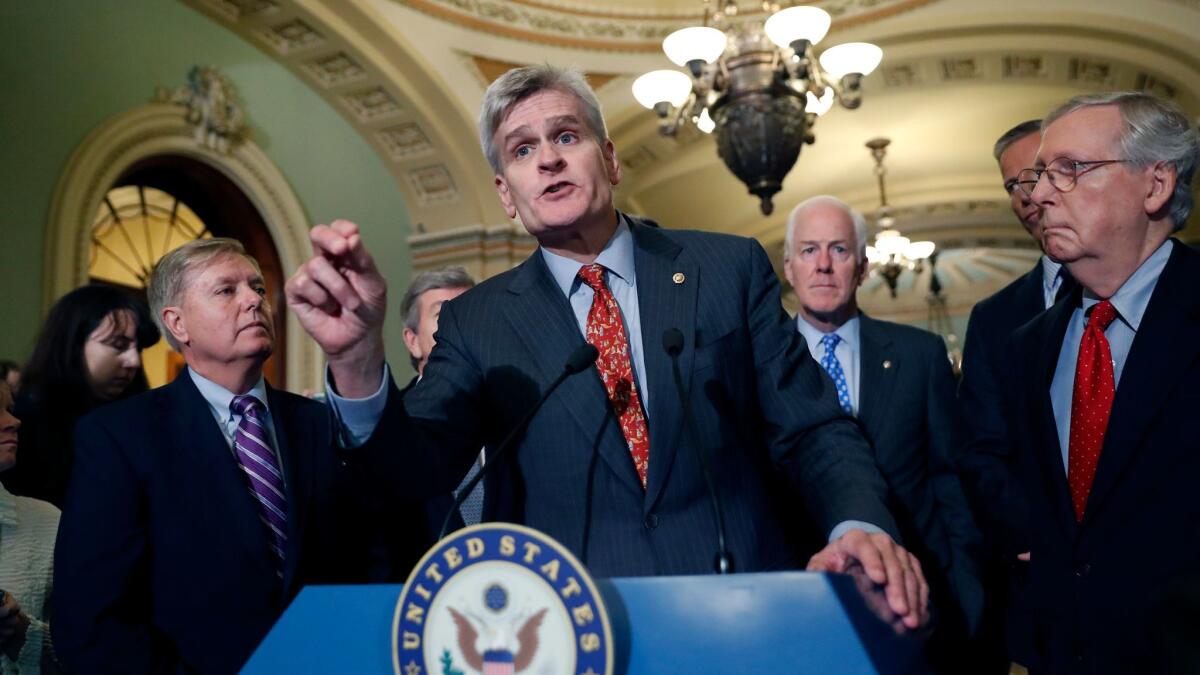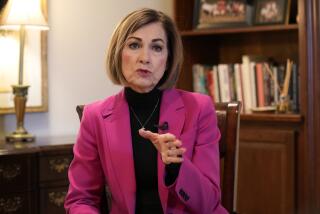Opinion: Believe it or not, Graham-Cassidy socializes the cost of health insurance

There are plenty of things wrong with the Graham-Cassidy-Heller-Johnson proposal to overhaul Obamacare (and Medicaid, while it’s at it), from its cockamamie approach to helping people not insured by their employers to its blithe indifference to the rising cost of medical care.
But give sponsoring Sens. Lindsey Graham (R-S.C.), Bill Cassidy (R-La.), Dean Heller (R-Nev.) and Ron Johnson (R-Wis.) credit for doing something remarkable: They got even the most conservative of their Republican colleagues to agree to socialize more of the cost of health insurance.
Wait, they did what?
Unlike previous GOP proposals to “repeal and replace” Obamacare, Graham’s legislation would leave in place almost every new tax and tax increase the Affordable Care Act imposed, including those on high-income Americans, health insurers, tanning salons and drugmakers. Doing so would raise about $1.2 trillion over the next 10 years; the Graham-Cassidy proposal would put that money into block grants for states, replacing various subsidies in the ACA for health insurance and care for low-income Americans.
Republicans and Democrats can, and will, disagree sharply over the wisdom of the change. But what’s being missed here is that Republicans are proposing to use a metric megaload of federal tax dollars to do the same thing Democrats did through the ACA: make health insurance more available and affordable. After all, under Graham-Cassidy, the block grant funding would have to be spent to help provide health insurance to high-cost individuals, or to help insurers cover losses (presumably from such individuals), or to help low-income residents obtain coverage and care.
Put another way, the Graham-Cassidy proposal would socialize some of the cost of healthcare for millions of Americans, to the tune of more than $1 trillion per decade.
Sen. Rand Paul (R-Ky.) has cited this spending as the reason why he’s adamantly opposed to the proposal. But no other Republican has; instead, a few GOP senators have complained that the bill may not provide enough money for their states, or that it has been force-marched through the Senate with no hearings or vetting.
It should be noted that this country already socializes a large percentage of healthcare costs through the tax exemption for employee insurance premiums as well as Medicare, Medicaid and other public health insurance programs. The Affordable Care Act pushed that percentage a bit higher; Graham-Cassidy would dial it back a little.
I suspect the proposal’s supporters don’t look at it as a way to perpetuate the transfer of wealth from taxpayers to insurance buyers (or, less directly, to insurance companies and healthcare providers). But that’s what they would be voting for.
And that’s something Democrats and Republicans could build on, should Graham-Cassidy fail to pass the Senate. Granted, it would require both sides to step out of their ideological bunkers. Democrats would have to accept the idea that Obamacare didn’t come up with the perfect solution to insuring people not covered by large employer plans — in fact, it piled too much cost on too few people. And Republicans would have to agree that the federal government can play a bigger role in helping Americans with healthcare costs that are too great for those of limited or even ordinary means to afford.
If the two sides can agree on those points, it shouldn’t take a herculean effort to come up with an approach to insuring the 20 million or so Americans in the non-group market that both sides can embrace. Because all of the sturm und drang about preserving or repealing Obamacare essentially comes down to this: How do we enable those people to be insured? Once both sides are willing to answer that question with federal tax dollars, it’s just a matter of figuring out how best to control the costs.
By supporting Graham-Cassidy, Republicans would be anteing up $1.2 trillion over the next 10 years to help bring coverage to folks in the non-group market, as well as to low-income Americans not eligible for Medicaid. That would be quite a step toward a bipartisan agreement, if only they recognized what they were doing.
Twitter: @jcahealey
More to Read
A cure for the common opinion
Get thought-provoking perspectives with our weekly newsletter.
You may occasionally receive promotional content from the Los Angeles Times.







